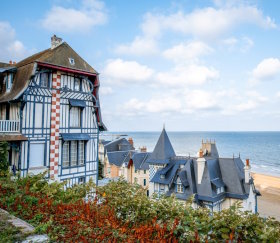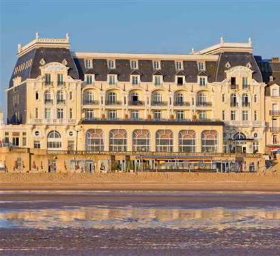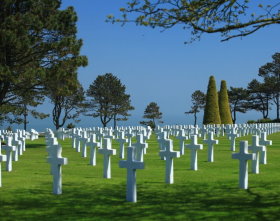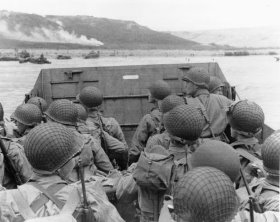Normandy Beach resorts. Beach hotel
Normandy Beaches include D-Day Beaches and famous Normandy beach resorts. D-Day Beaches made history through June 6th 1944 D-Day landing, a turning point of WW2. Deauville and Cabourg are the most famous Normandy beach resorts. Normandy Beaches are one of the best destinations for a one day trip from Paris. Famous places in France.
Normandy Beach resorts
The most famous beaches in Normandy are D-Day Beaches. They attract many visitors, and are pleasant beaches in their own right. Besides them, a great deal of the coast of Normandy has first class beach resorts.
Ahead of Cabourg, Houlgate and Trouville Normandy beach resorts, Deauville oozes style. Glamorous events abound, from prestigious horse races and polo to the annual Deauville American Film Festival. Golf and thalassotherapy abound. Enjoy the elegant hotels, boutiques and restaurants, not forgetting Deauville’s greatest pull, its magnificent beach.

Deauville beach resort is world famous
Cabourg Normandy Beach resort hotel
The prestigious 5-star Grand Hotel in Cabourg, where writer Marcel Proust once lived, is located directly on the seafront in Cabourg. It offers stylish guestrooms, some with views of the sea, a gourmet restaurant, a bar and access to a private beach. A Grand Buffet with music is served each morning at Le Grand Hotel Cabourg. The restaurant offers a panoramic view of the sea and serves gourmet regional dishes.
Cabourg 14390 France

The Grand Hotel in Cabourg is on the beach
Normandy Beaches tour from Paris
On D-Day, the Allies opened a new European front against the troops of the Third Reich during the Second World War. It was the largest military operation in history and marked the beginning of the Battle of Normandy which led to the end of WWII. This popular bus tour is an emotional one day bus tour from Paris to Normandy beaches to relive the important hours of D-Day landing and of the battle of Normandy. Visit Pointe du Hoc, the American Cemetery of Saint Laurent, Omaha Beach, Arromanches, the Caen Memorial. Check D Day beaches map.
Book Normandy Beaches tour. Bus tours from Paris to Normandy.

Normandy beaches are the closest to Paris
D-Day Beaches main sights
75 years after D-Day landing, Normandy is attracting a growing number of visitors related to memory tourism. 94 sites attract almost 5 million visitors a year. D-Day Beaches main sights are Pointe du Hoc, the Colleville American Cemetery, and Arromanches. If you have more time, visit the Caen Memorial. The D-Day Beaches region is quite lovely. We also recommend you to visit the city of Bayeux and its famous tapestry, the city of Caen and the lovely Beuvron village. Don't miss the food in Normandy which is excellent. Many restaurants are quite affordable. Normandy beaches map

The American Cemetery is in Colleville sur Mer
D-Day Beaches sight information
Omaha Beach Museum: located on Omaha Beach where the American naval landing took place on June 6, founded in memory of all those young men who died in 1944.
Utah Beach Museum: Admire an original B26 bomber, one of only six remaining examples of this airplane still in existence worldwide, and relive the epic experience of American soldiers.
Arromanches: world famous for its artificial harbor.
Pegasus Bridge Memorial; Pegasus bridge was a major objective of the British airborne troops on D-Day.
Caen Memorial: the largest museum on D-Day landing and the Second World War.
Normandy American Cemetery: 172.5 acres with the graves of 9.386 of military dead, most of whom lost their lives in the D-Day landings and ensuing operations.
Deutsche Friedhof von La Cambe: 21.222 soldiers are buried in the largest German Cemetery in Normandy.

Pointe du Hoc is a top sight of D-Day Beaches
D-Day detailed history
On June 6, 1944, at dawn, an armada of 4 266 transport ships and 722 warships approached the Normandy coast. It spanned a 35-kilometer front and transported no less than 130 000 men, most of them British, American or Canadian. More than 10 000 planes protected it. Named after the code name Overlord, this naval air operation remains the most gigantic in history, remarkable as much by the human qualities of its participants as by the prowess in terms of logistical organization, industrial and technical innovation. It had been awaited for more than a year by all Europeans who, on the continent, were fighting against the Nazi occupation. At the beginning of 1944, the Soviets crossed the Dnieper and invaded Romania and Bulgaria. For the Germans, defeat was only a matter of a few months. The opening of the second front to the West had to be speeded up. Dwight Eisenhower and his assistants, the American generals Omar Bradley and George Patton as well as the British Marshal Bernard Montgomery, decided to land in Normandy, south of the Seine. The sandy beaches which stretch between the Seine estuary and the Cotentin peninsula made for a quick landing and were less well defended than the northern ports. The objective was to install a beachhead on these beaches then to seize the deep water port of Cherbourg in order to intensify the landings of men and equipment. However, impressive fortifications dotted the oceanic coastline from the Pyrenees to Norway : the Atlantic Wall. The Cotentin hinterland had been flooded by the Germans in January 1944 and protected against possible landings by piles, trenches, mines. Hitler himself eagerly awaited the landing. He believed he could easily repel it and, in this way, put the Anglo-Saxons out of play before transferring all his forces against the Red Army. He was convinced that it would take place north of the Seine, at the narrowest point in the English Channel and only 300 kilometers from the industrial center of the Ruhr area. The Allies did their best to convince him. They set up Operation Fortitude for this, with, facing Pas-de-Calais, in the Kent countryside, an impressive concentration of armored inflatable tanks and planes in plywood. This intoxication would allow the Allies to face only 17 German divisions out of the 50 present in the region, the others awaiting in the North a second landing which would never come. German forces in Normandy totalled nearly 300 000 men. They were placed under the high command of the prestigious Field Marshal Erwin Rommel.
As the weather was bad on the Normandy coast in the first days of June which ruled out any attempt to disembark, Rommel took the liberty of a car trip to Germany to celebrate his wife's birthday. He did not anticipate that the weather would suddenly turn fine on the night of June 5 to 6. That night, there were only 50 000 soldiers to face the Allied armada, half of whom were non-Germans forcibly engaged and whose warrior value was not the first quality. Due to the storm in the English Channel, Eisenhower had already postponed the landing from June 4 to 6. On June 5, finally, his weather service promised him a 36-hour lull and he decided to immediately start Operation Overlord. Around midnight, three hundred scouts were parachuted for good behind the coastal marshes on the Cotentin peninsula. They marked the landing grounds intended for the gliders which followed them. 23 500 paratroopers from three airborne divisions were dropped behind the German lines. Their mission was to clear Utah beach and cut the national road that connects Caen to Cherbourg at Sainte-Mère-Église. Some paratroopers of the 101st Airborne fell by mistake in the center of the village where they were machine-gunned by the Germans before having landed. Inland, resistance networks were being activated. They were informed of the landing by coded messages from the English radio, the BBC. Among them two lines by Verlaine: "The long sobs of the violins of autumn, Wound my heart in a monotonous languor ”.
In the morning of D-Day, at 5.30 a.m., the Allied planes and half a dozen battleships bombarded the fortifications of the beaches and cliffs. An hour later, five divisions (two American, two British and one Canadian) began to land on as many beaches with coded names. From west to east, Utah and Omaha (American troops), Gold (British troops), Juno (Canadian troops) and Sword (British troops and French detachment). The men advanced on the beaches under the fire of the Germans who shoot from the top of the blockhouses, the latter being themselves pounded by the Allied battleships from the open sea. The resistance of the Wehrmacht was tough despite the mediocrity of the troops, especially on Omaha Beach where the Americans are on the brink of disaster. Luck ultimately smiled on the Allies. During the whole day, they only had to face two German fighter planes. As for the formidable Panzers or German tanks, they inexplicably remained in reserve inland, apart from a counter-attack in the early morning on Sainte-Mère-Église. Thus at the end of the day, despite the confusion and the misconduct of the command, 135 000 men had already managed to set foot on French soil. The American cemetery of Colleville-sur-mer (DR) The white cemeteries of the cliffs still bear witness today to the price of these heroic, bloody and often disorderly actions. The Americans deplored 3 400 killed and missing, the British 3 000, the Canadians 335 and the Germans 4 000 to 9 000. Three-fifths of the Allied losses occurred on Omaha Beach. But, overall, they turned out to be much smaller than expected. The bombing of Norman towns and communication nodes also killed 2 500 civilians. On the evening of June 6, the Allies finally succeeded in establishing a bridgehead on the coast. They could set up all the logistics essential for the landing of millions of men, for a long-term offensive.
History of D-Day
On June 6, 1944, 160 000 Allied Troops landed on a 50 mile stretch of fortified French coastline to fight Nazi Germany on the beaches of Normandy.
The commander in chief of the troops, General Eisenhower, called D-Day a crusade in which «we will accept nothing less than full victory». More than 5,000 ships and 13,000 aircrafts supported the D-Day invasion. By D-Day's end, the Allies had gained a foot-hold in Normandy.

D-Day Beaches: Arromanches
Thanks to D-Day Fighters
The cost of D-Day was high with more than 9 000 soldiers killed or wounded. Allied forces that saw combat on D-Day came from Canada, the UK, the USA and France. Polish forces joined a few weeks later.
There were contingents from Australia, Belgium, Norway, Czechoslovakia, Greece, the Netherlands.
France and Europe will never forget all those who fell in combat to free their countries from the Nazis.

American assault troops on D Day
